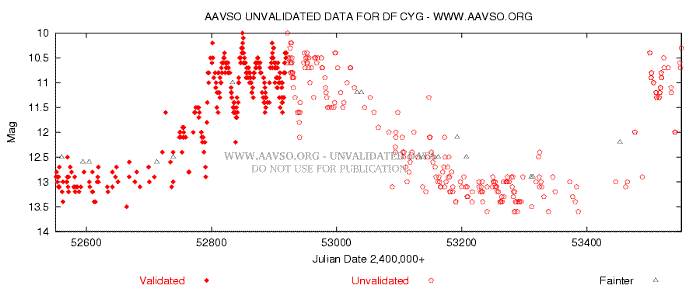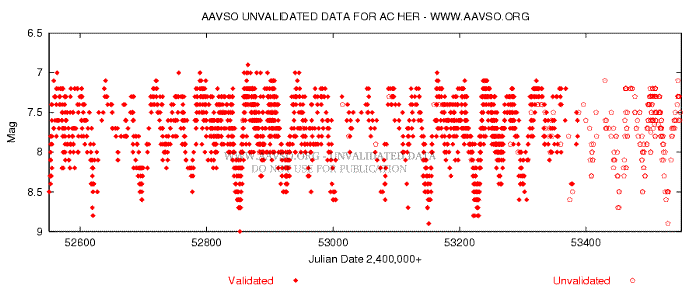

Campbell and Jacchia in The Story of Variable Stars, the best book ever written on the subject, associate the RV Tauri stars with a certain cachet, some sort of snob value among stars as though all sorts of diverse objects were trying to get into the RV Tauri club, and it has to be admitted that the name does have a certain je ne sais quoi about it, even though no-one is quite sure where it comes from. The best known of the group, R Scuti, is perhaps the least typical, and RV Tauri itself one of the least active. Their light changes take the form of more or less constant variation, but with alternating bright and faint minima. RV Tau stars are reasonably regular, at least among those with the shorter periods. One star I follow religiously, EZ Aquilae, has a period of only just over a month, comparable with the Cepheid variables. The RV Tau stars actually share a great deal with those paragons of regularity; they form a sort of bridge between the two great groups of pulsating stars - the classical cepheids and the Mira stars.
Recently, mathematical investigation of their light variations has revealed chaotic processes at work, which is usually a sign of a dynamical system dominated or at least strongly influenced by turbulence within the system. The turbulence here presumably derives from structural, pulsatory processes in the interior of the star.
The RV Tauri stars are, like the Miras, large, luminous objects, though they are yellow rather than red in colour; R Scuti and U Monocerotis actually come within naked-eye visibility, and AC Herculis is visible at all times with binoculars, whilst owners of large glasses may also be able to cover the southern equivalent, IW Carinae (Details of this star can be found higher up the site in the online Handbook of Binocular Astronomy) or you can link straight to it from here. These stars are not nearly as plentiful as the Miras, however, so this trawl through my fave Harvey Tau's will, of necessity,be a bit shorter than previous chapters.
This is a notable member of the RVb type stars, that is, those in which the mean brightness of the main light-changes varies as well. This star has one of the largest ranges of any RV Tauri star, from magnitude 10 to 15, and is easy to find from a beautiful bright trapezium not far from delta Cygni. The short-term period is about fifty days, so you need to look at it once a week if you want to try and construct your own light-curve. A portion of the AAVSO results for this star appears below. Notice how when the star is bright (say around 52900), the periodicity is much more marked. As it fades (53300) the periodicity not only diminishes, but the variation themselves also lessen.

I became a devotee of this star when I used binoculars during the early '70s, and I still retain fond memories of it as an old friend, though I have not seen him for a while. It is good to look at stars for old times' sake; even though there is no need for me to look at them in terms of the fruitful addition of knowledge, I still like scouting stars such as AF Cygni or AC Herculis - simply because I grew up with them. AC Her is a great star to follow as it always seems to be doing something variable within its little fan of eighth-magnitude stars. The lightcurve below shows the RV Tauri double minimum trait very well. Observe this star once a week.

As far as I know, this has the shortest period of any RV Tauri star, just 38 days. It lies in a most recognizable little group of stars, including a tiny line of 12.7, 13.1 and 13.4 only a minute of arc to the North. It has a range of 11.6 to 13.6 and lies in a crowded field not far from Altair. You may be able to notice its yellow-gold colour when it is bright. This is a fairly underobserved star which is on the preliminary programme of the AAVSO. I have joined the points by lines (as there are relatively few data points due to this star being not very well observed) to show the variations.

For some reason, Ophiuchus seems to contain more of these stars than other constellation - well, it is a very large group near the Milky Way, and RV Tauri stars do tend to hug the galactic plane, as do the related Cepheids. TT and TX Oph are not too far away from each other, and there are more stars of similar type close by. UZ is the most endearing to my mind, usually varying between magnitudes 9.5 and 12 in a period of 87 days. Two 10th-mag stars point straight to it, and there is a neat little double star closely North-East. The field is easily found from sigma Oph. The curve here shows variation over a 200-day period so that you can see the bright and faint minima more easily - including a particularly faint minimum.

Per Ardua AD Aquila...As yet, I have not even had a chance to observe this very well myself, so the chart supplied here will be new for all of us! AD Aql lies in a crowded region right on the borders of Aquila and Scutum, and the chart represents a very small area of the sky.
The range is from 11.5 to 13.5 photographic, and bearing the F-type spectrum in mind, the visual range may be expected to be very slightly brighter. Its period is 65 days, so observe it once a week if you can.